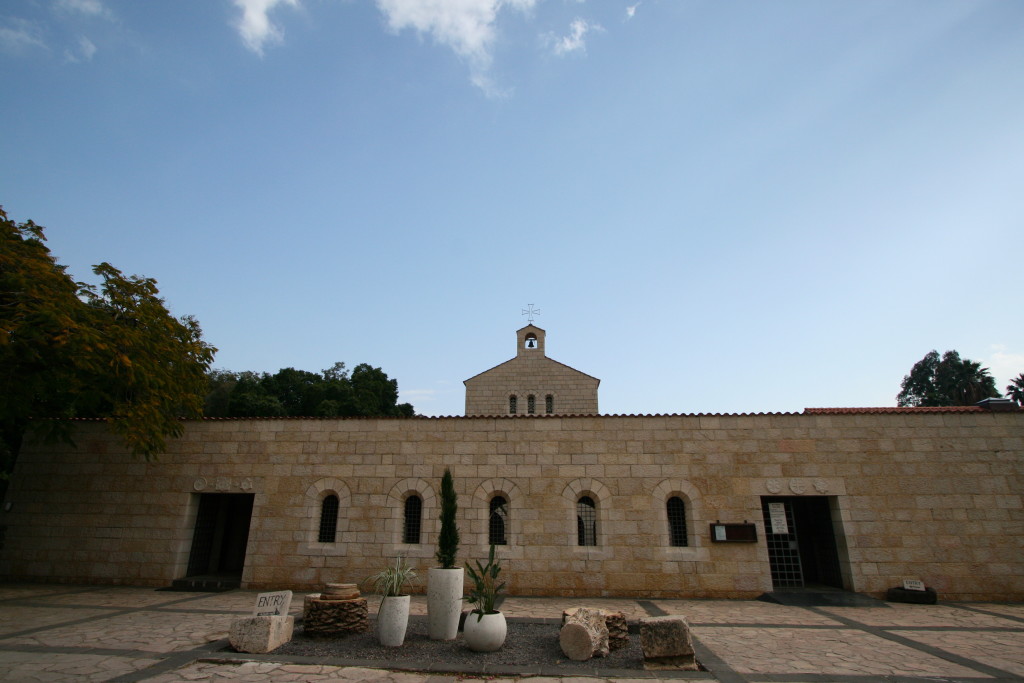
Aqueduct at Caesarea -built to carry water to Caesarea. It maintained a 1 degree downward slope over a 12 mile distance. We ended the day with another 1 ½ hours of travel, by bus, to the Sea of Galilee which will be our base for the next 2 days. We ended the day with a delicious buffet dinner of various Kosher meats and vegetables, as well as desserts – a tremendous treat after 24 hours of airport and airplane foods. We made it to bed before midnight, with a wake-up call coming at 6:15. Lila Tov (Good Night)
DAY 2
Today was our first full day in Israel and we spent the whole day in the region of Galilee. Galilee was the area in which Jesus spent most of his earthly ministry – teaching and performing miracles.
We began the day with a drive halfway around the Sea of Galilee and up the steep road to Mount Arbel. We hiked a short distance to a cliff overlook that gave us an amazing view of the surrounding Galilean countryside. To have this view was so fantastic- it gave us a complete overview of the area we would be touring for the day. We could see the Sea of Galilee, Capernaum, Chorazin, Magdala, the area northwest of the sea known as the Decapolis, and the many hills and valleys of Galilee where Jesus walked and lived. During His time there were forested hills and deep valleys with numerous villages. Today there are hills with bushes, rocks, and many wild flowers , but larger villages and towns in addition to the much larger city of Tiberias. During Jesus’ day the mild climate produced olives, grapes, figs, wheat, and barley, as well as grass for grazing flocks. Today there were fields of wheat and groves of olives, mangos, and pomegranates, and, surprisingly, also bananas! Although there were a few cows on the hillside, the area no longer supports large herds of livestock.

Sea of Galilee and Northern Region

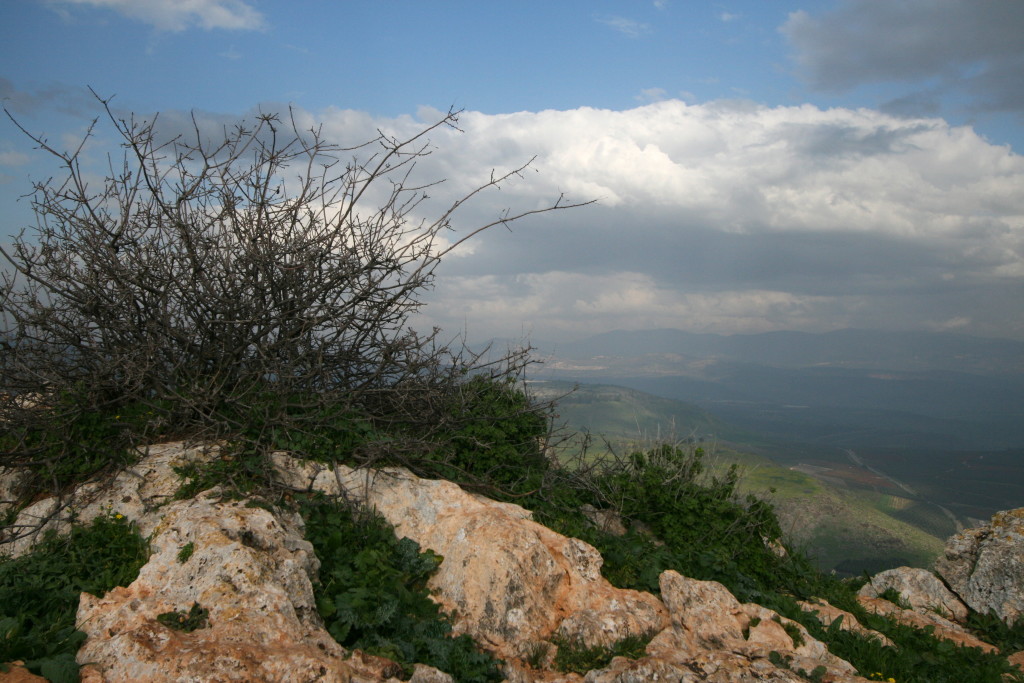
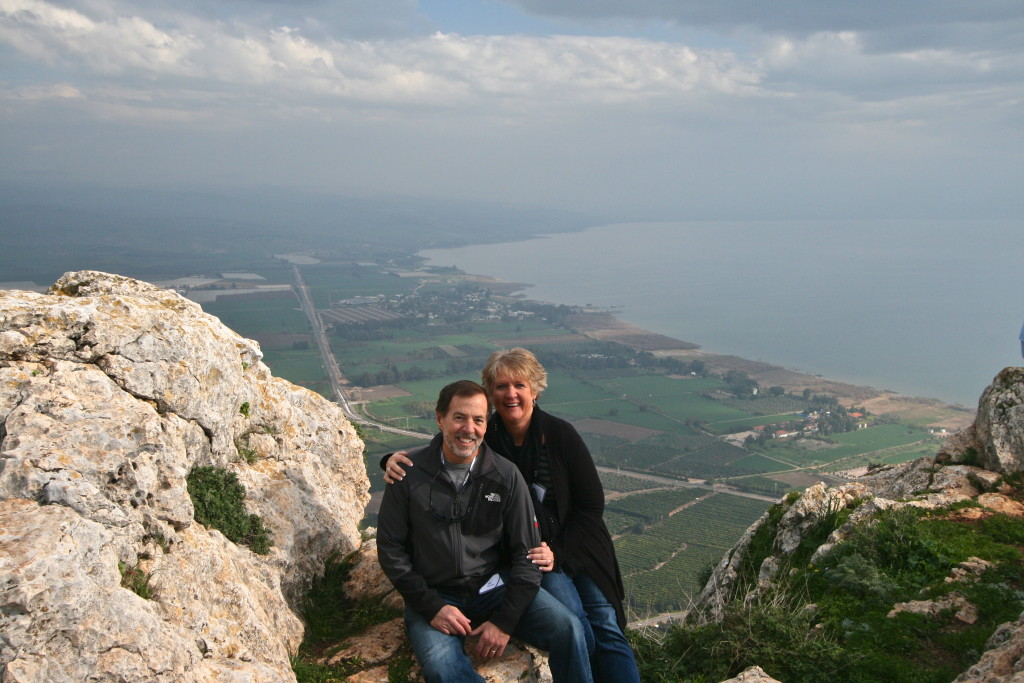
Next, we traveled to Tabgha – the site of several springs that flow into the Sea of Galilee. This location has been traditionally named as the place where Jesus fed the 5,000, but Luke 9:10 and John 6:1-15 indicate that Jesus performed the miracle on the northeastern side of the Sea of Galilee, beyond the city of Bethsaida. The Church of the Multiplication is built on the traditional site.
Church of the Multiplication
Located on a small hill overlooking the Sea of Galilee near Tabgha, the Mount of Beatitudes is the traditional site of Jesus' delivery of the Sermon on the Mount. The Church of the Beatitudes was built to commemorate this important aspect of Jesus’ministry.
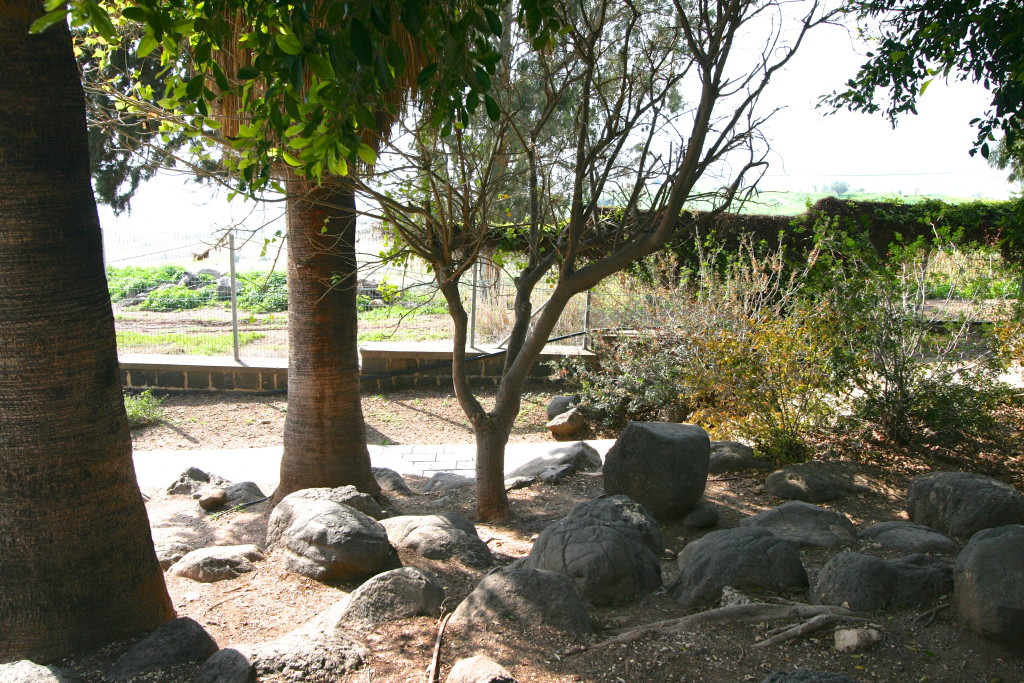
A site on the Mount of Beattudes where Jesus may have taught

Church of the Beatitiudes
Very close to Tabgha is the likely spot where Jesus met with the disciples after His resurrection. Jesus had told them to meet Him in Galilee and here Jesus had prepared a fish-breakfast for Peter and the disciples after their long night of unsuccessful fishing (Jn 21:1-21). The Church of the Primacy of St. Peter commemorates this site.

The Church of the Primacy of St. Peter
We then took a boat ride across the Sea of Galilee back to the town of Tiberias. The boat ride was wonderful and was one of my (Deb) favorite parts of the day. I had to keep reminding myself that this is really the exact location, in the very seas where Jesus walked on the water and Peter asked to join him. Then, another time, when a storm suddenly arose while Jesus was sleeping in the boat and his disciples were rowing and fretting (waking Jesus up and claiming that He did not care if they perished), Jesus calms the wind and waves with a word! Our day at sea was windy and I could not help but think that a storm could possibly come up quickly as they can often do. I also asked Jeff if he wanted to try walking on the water and he said, “no.”
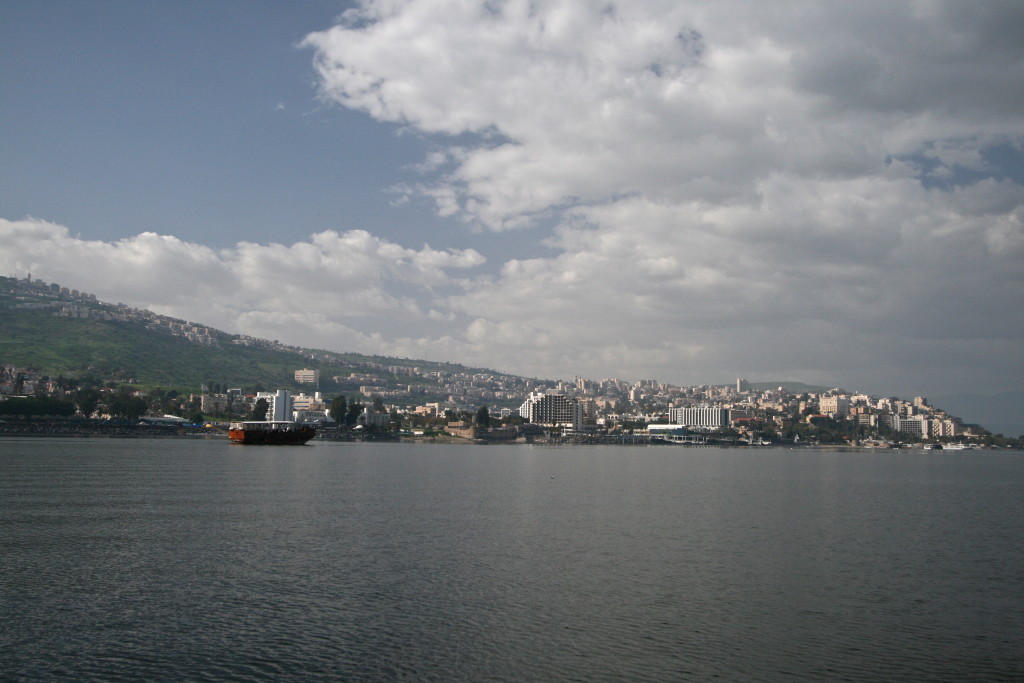
The city of Tiberias
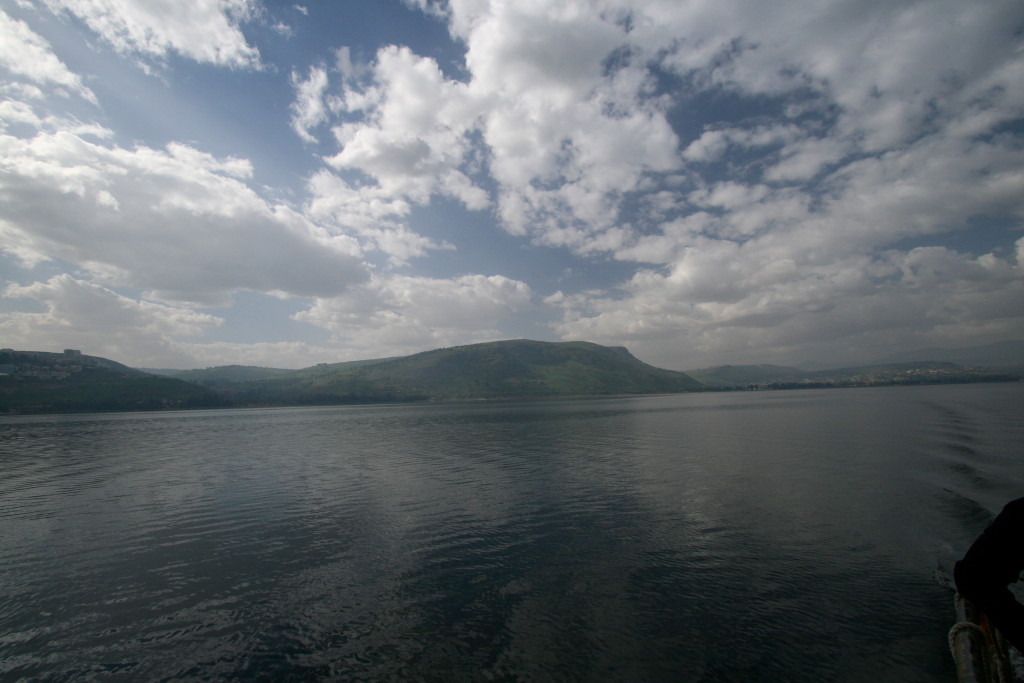
View across the Sea of Galilee
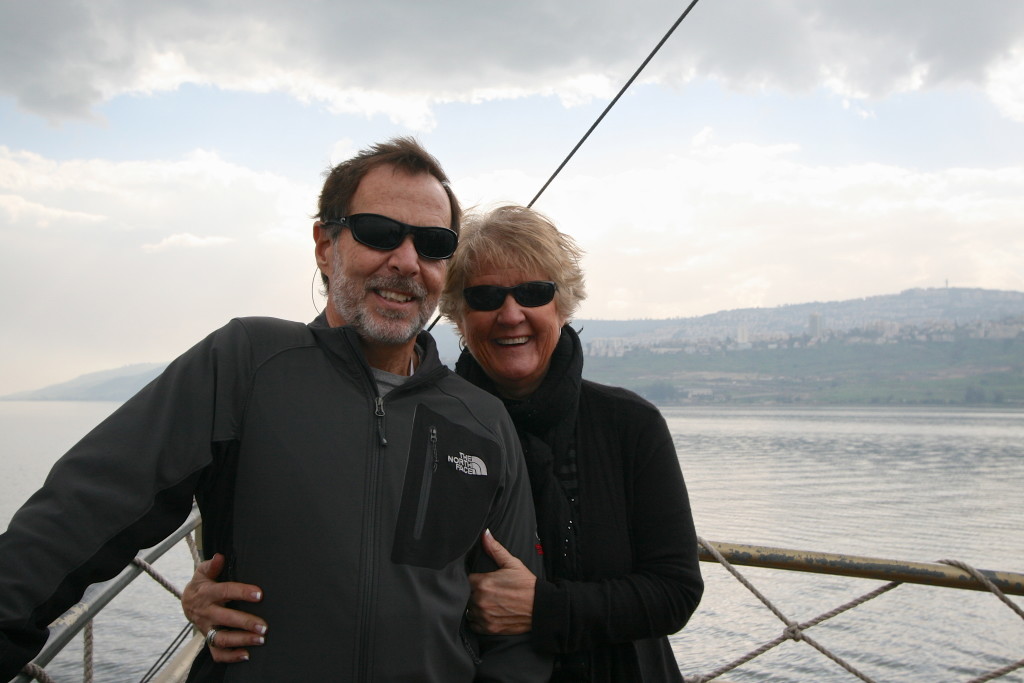
Our last stop of the day was Capernaum. Both Jeff and I agreed that this, in addition to the views from Mt. Arbel, were our favorites- a great beginning and a great ending to the day. Capernaum was an important town on the Sea of Galilee, with access to the fishing industry as well as the international highway that ran from Mesopotamia to Egypt. Because of its strategic location, it was important to the Roman Empire, which stationed a centurion and detachment of troops, a custom station, and a high officer of the king. Jesus moved here after his rejection at Nazareth and made it the center of his activity for18-24 months. Peter, Andrew, James, and John lived here and were called to be disciples here (Mt 4:13-22).
At Capernaum, Jesus: called Matthew (Levi) from his tax office, taught in the synagogue; healed many including Peter’s mother in law (Mk 1:21-); healed the centurion’s servant (Mt 8:5-13); healed the paralyzed man let down through roof (Mt 9:1-8); raised Jairus’ daughter from the dead (Mt 9:18-26); and healed many other sick people here. In fact more healings were recorded in this city than any other city, yet they still did not believe.
Today there is nothing left of the town. No village or city exists there today. Jesus had cursed Capernaum, Chorazin, and Bethsaida for their unbelief. All three are non-existent today. With only ruins- all destroyed by an earthquake.
There are, however, ruins of a synagogue and houses located there. The synagogue was beautifully located overlooking the Sea of Galilee. It was amazing to stand in the very synagogue in which Jesus regularly taught and ministered.
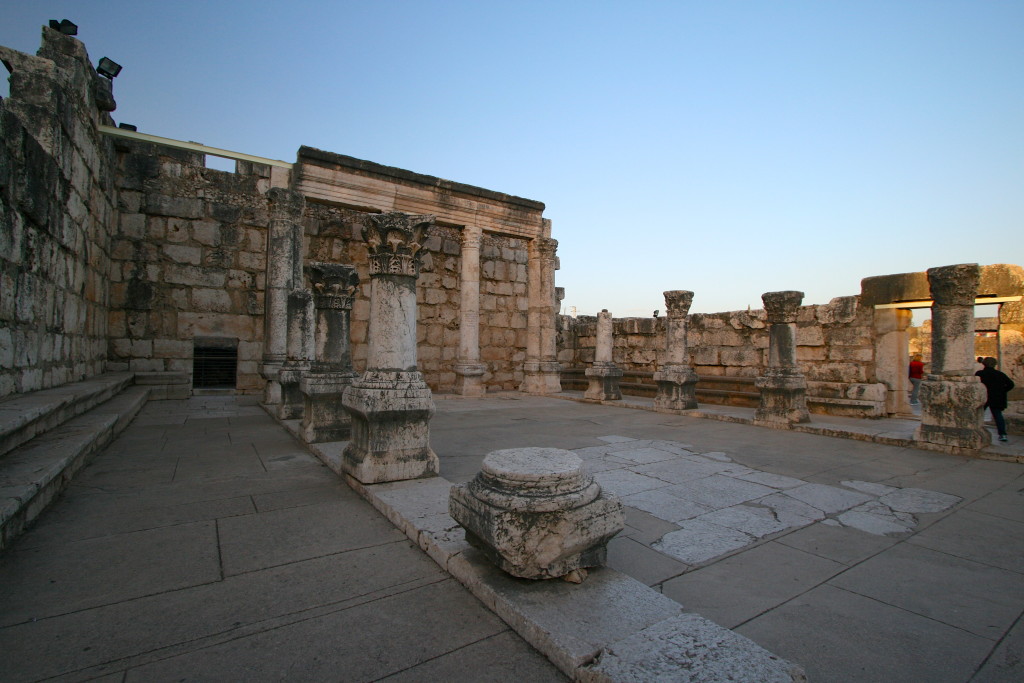
Courtyard of the synagogue in Capernaum where Jesus would have taught
Courtyard
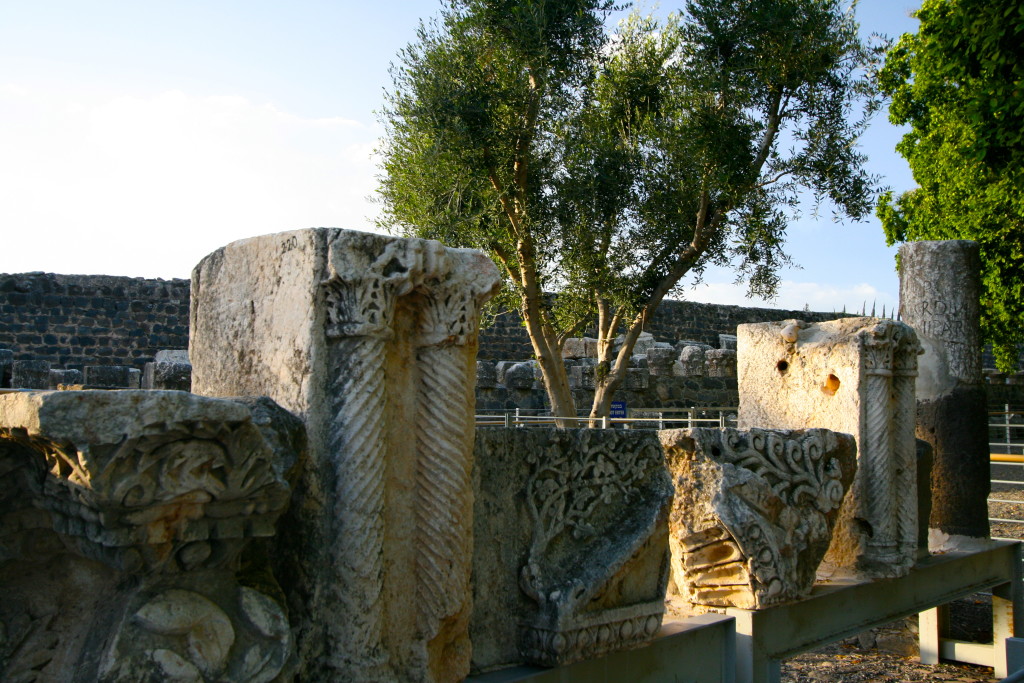
To say that it is very hard to wrap our minds around the fact that we visited and walked where Jesus lived and walked is a huge understatement. We are both amazed, humbled, and grateful to have this experience, to be able to put a visual context to the words of scripture and the stories of Jesus’ life and ministry. We praise God for the opportunity.
We returned to our hotel in time for our nightly Kosher buffet – this time on the evening of the Sabbath.

Evening view from our room overlooking the Sea of Galilee
Shabbat shalom. Lila Tov.
DAY 3
After an early breakfast, our journey today began with a rather long bus ride around the southern coast of the Sea of Galilee, then west to Megiddo. As we drove along the coast, we saw very few fishermen on the sea or along the shore. David, our guide, told us that there are few fish left in the sea today. I looked across the sea and was reminded again of the great number of fish caught by by Peter when he followed Jesus’ instructions to cast the net one more time after a night of catching nothing.
As we travelled we also saw groves of lemons and orange and banana trees in this fertile area.
We then passed Mt. Tabor, where it is believed that Jesus revealed His glory to Peter, James, and John on the Mount of Transfiguration (although there is some debate that this may, in fact, have occurred at Mt. Hebron, which we will visit later today).
We then traveled to the ancient city of Megiddo, which lies at the southern end of the Jezreel Valley (Plain of Esdraelon). The city guarded a strategic pass through Mount Carmel. At least 26 different cities were built on top of one another over the years, as the city was occupied by various conquerors. Because of its strategic location, this area was the scene of many famous Old Testament battles:
Joshua defeated the king of Megiddo during the conquest of Canaan (Joshua 12:7). God gave the city to the tribe of Manasseh, but they failed to drive out the Canaanites (Judges 1:27). Deborah and Barak defeated Sisera and his armies “by the waters of Megiddo”(the Kishon river that flows through the valley of Jezreel). (Judges 5:19-20). Josiah, the last good king of Judah, attempted to prevent the armies of Egypt from passing through the land and was killed at Megiddo by Pharaoh Neco in 609 BC (2 Kings 23:29-30).

the original steps of the outer walls

The main gate entrance to Megiddo

A circular stone pagan altar in the temple area of Megiddo
From the vantage point of Megiddo we have a great view of the Plain of Jezreel. This particular plain creates the strategic land bridge that connects Africa in the south to passage to both Asia and Europe, and has been a hotly contested region throughout history, with many battles being fought here. The last great battle before Christ’s return will see the armies gather at Armageddon (in Hebrew Har Megiddo), meaning the hill of Megiddo (Rev 16:13-16).

Looking out over the Plain of Jezreel
We then traveled north to Nazareth, the place where Jesus grew up and spent most of His life. Nazareth sits on a hill overlooking the Jezreel Valley. In Jesus’ day, it was a small village of only100-200 people. Today it is a modern city of 80,000 people. Our bus driver, who is an Arab Christian who lives in Nazareth, dropped us off in the middle of the city and we walked through the crowded, narrow, bustling streets to view two churches, both commemorating the announcement to Mary concerning the birth of Jesus. Our Jewish Christian guide has pointed out some very interesting things that we had not ever considered. A point he made today was that Joseph was identified as a carpenter in the Greek text, but the Hebrew word has a more broad meaning of “builder”. Looking at the countryside, there are rocks and stone everywhere, but very few trees. It is likely that a builder in Galilee would be more likely to use stone rather than wood.

The Greek Orthodox Church of the Annunciiation is located over the spring where it is believed that Mary first heard the angel Gabriel's voice.
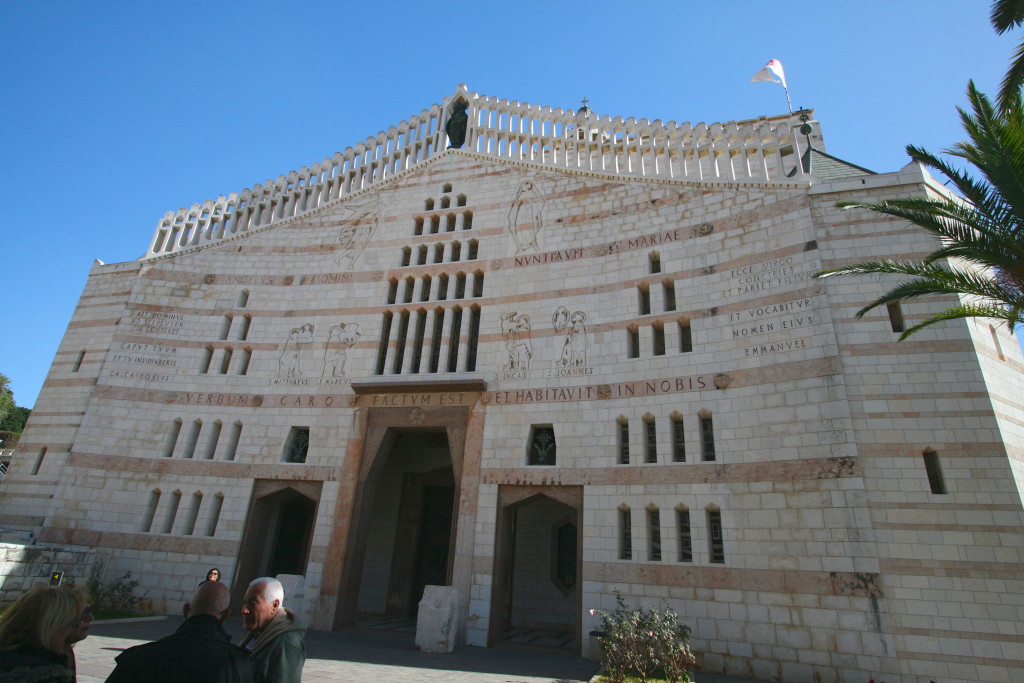
The Basilica of the Annunciation is a modern Catholic church built over the remains of Byzantine and Crusader churches. It incorporates the cave in which the Virgin Mary received the news from Gabriel that she would give birth to Jesus.
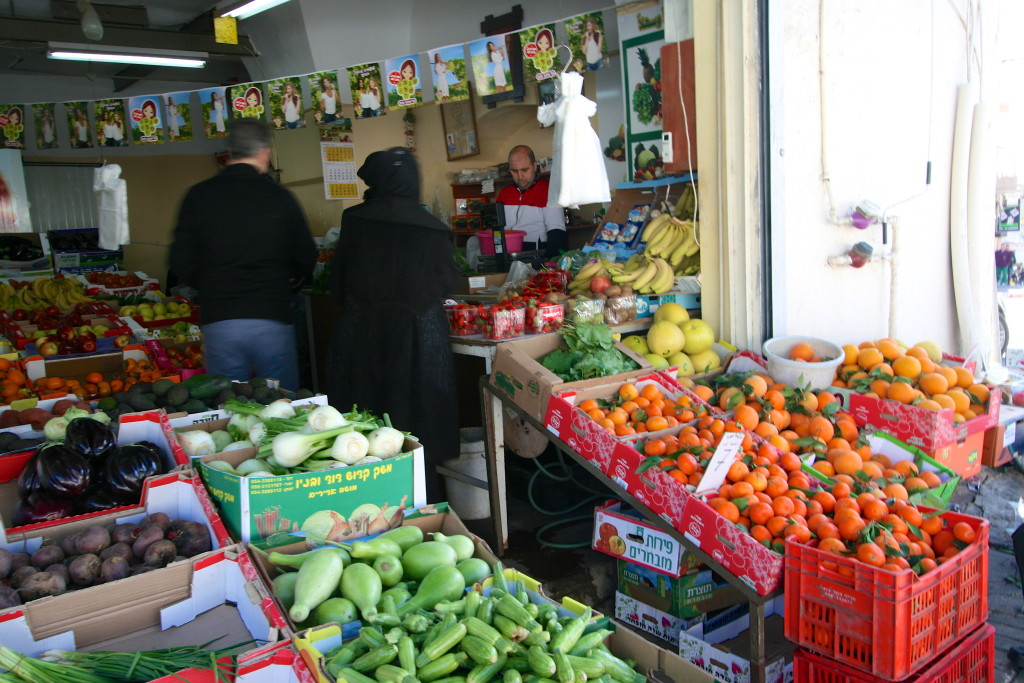
Marketplace in the inner city of Nazareth
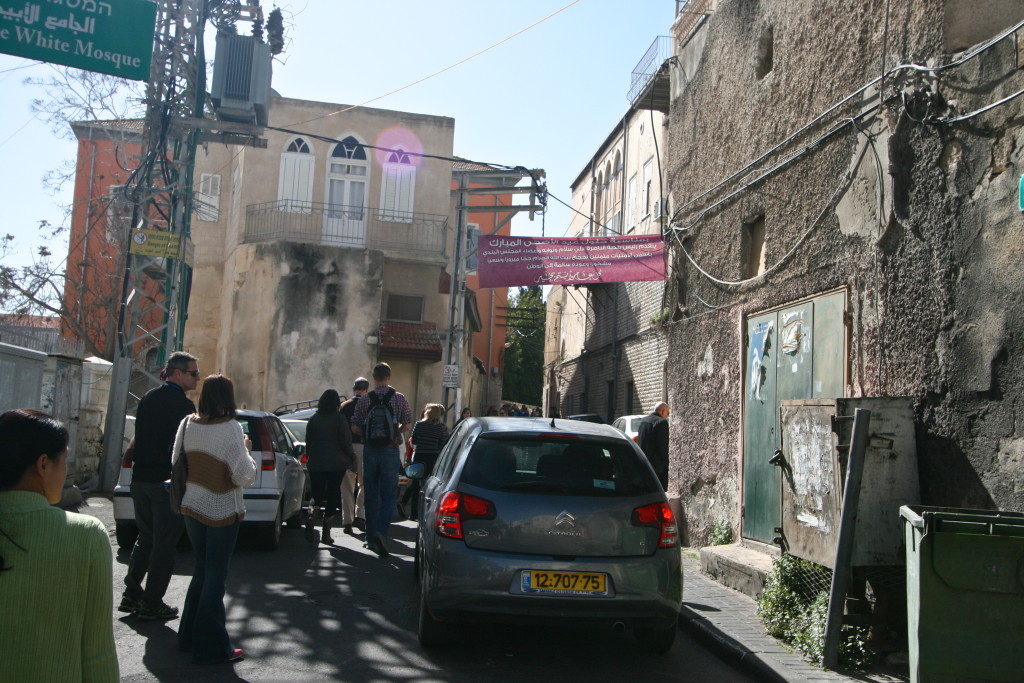
Nazareth street scene
I (Jeff) was also struck by a fact that we would not have known had we not had the opportunity to visit this area. The place where Jesus lived as a child and young man was on a hillside that looked directly down onto the Plain of Megiddo. He began his life as a humble child in an obscure place; from that vantage point He would daily look out and see the stage where the final acts of humanity will be played out prior to His return, when He will return as conquering king and Lord of Lords. What an awesome fact.
After grabbing lunch in Nazareth, we drove north through Cana (the place of Jesus’ first miracle) to Dan and Caesarea Philippi, in the northernmost region of Israel. Caesarea Philippi was the place that Jesus took his disciples for a retreat immediately prior to the start of His journey to Jerusalem. Here He asks them a very important question: “Who to people say that I am? Peter’s confession that Jesus was the Christ, the Son of the living God had special significance in this setting. The place was a notorious place of pagan worship, housing a shrine devoted to Pan, a Roman temple devoted to Zeus as well as a temple for the worship of the emperor. Most striking was the fact that a large cave adjacent to these places of worship was called “the gates of Hades” – it does not seem a coincidence that after taking the disciples to this distant Gentile location that He proclaimed that He would build His church and the “gates of Hell would not prevail against it”. Being able to visualize the setting where these words were spoken just amplified the truth that much more.

The Gates of Hades
Caesarea Phillipi is also was the location of the headwaters of the Jordan River, created by the runoff of melting snow from Mount Hebron

Origins of the Jordan River

We finished the day by driving along Israel’s northern border with Lebanon and Syria (not the most stable area). With Mt. Hebron to our west, we entered the Golan Heights. Israel currently holds about two-thirds of the territory, which it captured in the 1967 Six-Day War, while Syria holds the remaining one-third. It is a hotly contested area and is a critical buffer between Syria and Israel’s main water source – the Jordan River and the Sea of Galilee. As the sun was setting, we stood atop an Israeli outpost directly on the border looking down into Syria toward Damascus. In addition to the Syrian military outposts and scattered towns, we were able to see the road to Damascus, where the Savior apprehended Saul, the persecutor of Jewish Christians.
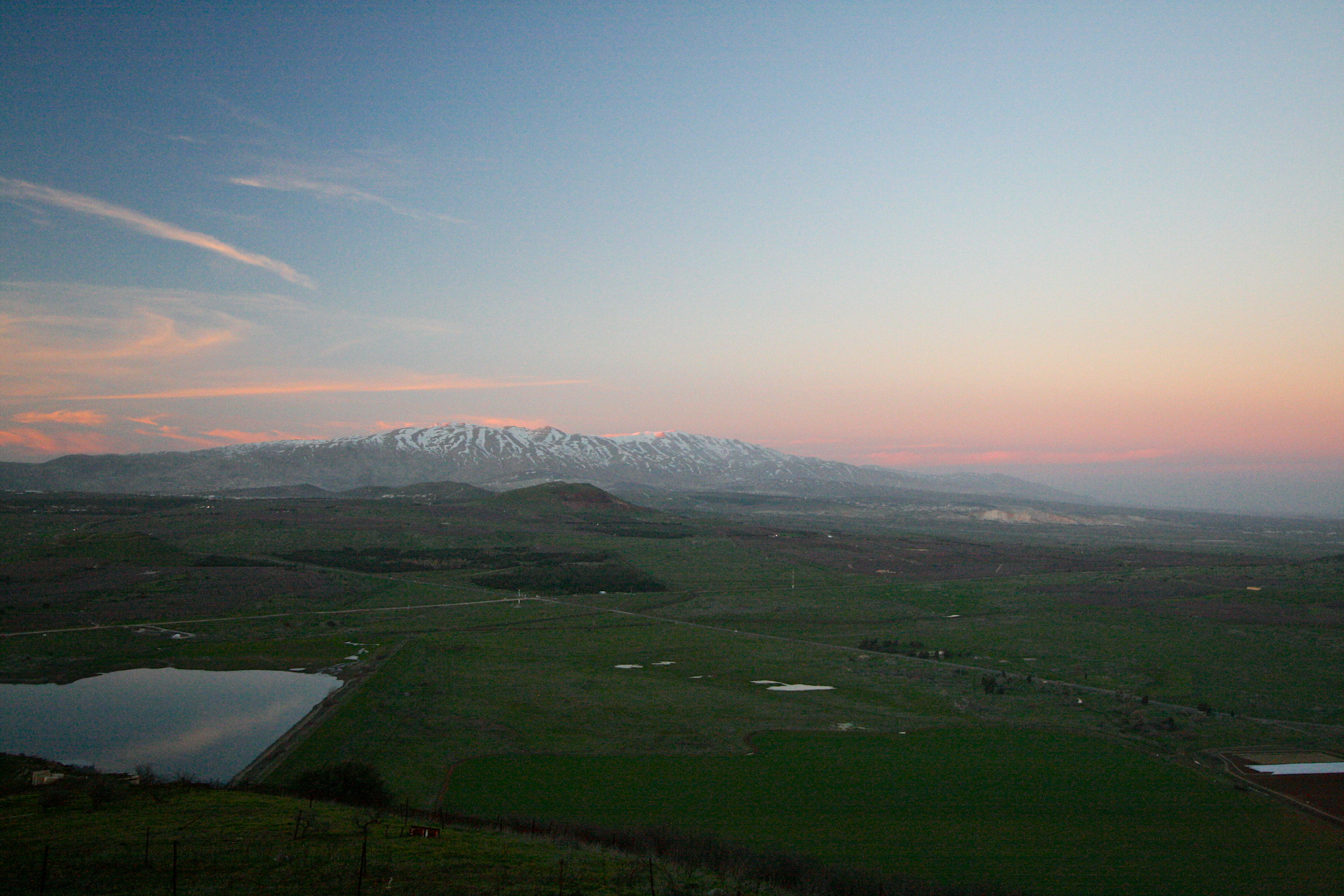
Looking into Lebanon, with Mount Hermon in the background
A view across the border into Syria, looking toward Damascus[/caption]
As we drove back to our hotel, we were again humbled by the day – the opportunity to put visual context to the truths that we know and to the places where Jesus lived and taught. What an incredible experience!

Sunset in the Golan Heights
Lila Tov
DAY 4
Another early start to a bright sunny day - we checked out of our beautiful hotel located on the Sea of Galilee and drove south again around the eastern shore of the sea.

Our last look at the Sea of Galilee as we leave our hotel
Our first stop was Genneraset, the place where Jesus encountered the man at the tombs who was possessed with many demons. Jesus commanded the demons to leave the man and enter into a large herd of pigs that was grazing on the hillside. causing them to run down a steep embankment and into the sea. They believe this to be the actual spot based on the topography of the eastern shore-this being the only place where a steep embankment led down to the sea. Jesus then tells this man to go a tell his brethren what has been done for him! This was unusual, in that previously Jesus had always told the recipients of his miracles to remain silent and not tell anyone. This area is in the southern portion of the region known as the Decapolis (the ten cities), which was Gentile territory. (Mark 5:1-17)

The hillside pasture where the pigs would have been grazing

Looking down the precipice into the sea
From this vantage point, we were able to view Mt. Arbor, Capernaum, Tiberias, and Mt Hermon for one last time. I (Deb) really did not want to say good-bye to the Sea and Galilee. It is a beautiful area and I loved being able to see, boat, and travel around the place that Jesus lived.
One last note before we leave: When Jesus spoke in his Sermon on the Mount he said that we are to be lights, lights like a “city on a hill that cannot be hidden”. This metaphor has taken on a new meaning as we looked at the surrounding area of Galilee and saw the backdrop of His teaching. The city of Zefat sat high on a hill and its lights at night would have lit up the horizon as the people of that area looked to the western horizon. WE are to shine brightly in word and deed so that all may see and know and glorify God. (Matthew 5:14-16)
But back to the story; so the bus was leaving, and we crossed the Jordan River one last time and headed south to the well–preserved ruins of the Roman city known as Bet She ‘an. The original city dates back to the 4th century BC, when the town was an important stop for caravans and as a center of Egyptian rule. Later, it became a Canaanite city, one that was not captured immediately by the Israelite conquest (Josh. 17:11, 16). However, it would eventually be allotted to the tribe of Manasseh (Josh. 17:11). It would be controlled by the Philistines until finally becoming an Israelite city in the time of Solomon. It was at nearby Mt. Gilboa that King Saul was wounded in an epic battle with the Philistines. Rather than allow himself to be captured by the victorious Philistines, Saul chose to fall on his sword. The Philistines then cut off his head and hung his body, and that of his sons on the city walls (I Sam 31:9). Eventually the Romans built a much larger city that included the ancient city, and it is these ruins, which remain adjacent to the remnant of the ancient walls.
The ruins revealed a typical Roman city of Jesus’ time, which included a central acropolis, a large arena, a 6000-seat theatre, veladrome, and a large agora (marketplace). There were bathhouses as well as a public latrine with running water. The mosaic tile work was amazingly well preserved and beautiful. The latrine was fascinating with numerous marble seats for all!

In the background is the ancient city of Bet She'an - some of the walls on which the bodies of King Saul and Jonathan were hung are still standing. The ruins of the Roman era city are in the foreground.

the Acropolis

the Agora

The marble-seated latrine
Traveling on, after leaving Bet She'an, we entered the West Bank and had to pass through a checkpoint, because the territory is under Palestinian jurisdiction. We then passed through a buffer zone separating Israeli and Jordanian territory, complete with mine fields on either side of the road.

Mine field separating Israeli and Jordanian territory

Electronic security fence that runs along the entire Israeli border
After passing through another checkpoint and buffer zone, we ended at the spot on the Jordan River where it widens before reaching the Dead Sea. This is the place where John baptized Jesus. Tim, our teacher, read the story from the Gospel of John and discussed the significance of that location in Jewish history. (It was near here that the Israelites crossed into the promised land (Joshua 3), as well as the area that Elijah crossed the Jordan with Elisha and passed the mantle of ministry to him (1 Sam 7). The Jordan River is the boundary between Israel and Jordan. As we sat and listened to the teaching, we could look across the Jordan and see armed Jordanian soldiers sitting directly across from us, with Israeli soldiers standing on our side.

The border between Israel and Jordan is the middle of the river, and the Jordanian soldiers were just across the river with Israeli soldiers on our side. Our guide discussed the fact that Israel has no current relations with Syria or Lebanon, but currently is “at peace “with Jordan and Egypt. It was obvious us, in light of the armed checkpoints, mine fields, soldiers patrolling, and frequent fly-bys of Israeli fighter jets, that the peace was very fragile. It is hard to believe that we are traveling through such an unstable part of the world.

Armed Jordanian soldiers across the Jordan river
The next stop was Qumran – the place where the Dead Sea scrolls were found in 1947. Their discovery is a very interesting story and for those who do not know it, here goes! In 1947, a Bedouin shepherd boy threw a rock into a cave and heard a loud clink! He went in and discovered a broken piece of pottery revealing a hidden scroll. From that point on an additional 900 scrolls were found hidden in 11 caves separate caves, the majority being discovered after 1967 when Israel regained control of the land. The Essenes, a renegade Jewish sect (known as the “pious ones”) lived in this wilderness area. Most likely the Essenes, hearing of the approaching Roman armies in the mid- 1st century, placed their scrolls in pottery jars and hid them in nearby caves. They then joined the rebels who captured Masada and were later killed by the Romans in AD 73. The caves contained all the books of the Old Testament, except for Esther, plus other Jewish writings not included in the OT. In addition many other scrolls from their community- all of these scrolls dating back to the first century BC. This was one of the most important archeological finds in history. The comparison between the book of Isaiah that was found, which is now the oldest copy on record, and the copy that we have today miraculously shows that there is no textual difference between the two. This proof of God’s s preservation of His word over two centuries of multiple copies and human transcription is truly miraculous.


Cave 4, where most of the scrolls were found

Looking east from Qumran, across the Dead Sea to Jordan
We boarded the bus one last time and headed for the south end of the Dead Sea. On the way we saw a few flocks of sheep being tended by modern-day shepherds. We are now in the wilderness. This truly looks like a wilderness – no trees except date palm trees; no greenery – just rocks and sand and tall, rocky mountains with scattered caves. These were the caves that David hid in when fleeing from Saul. I could not help but wonder - how did his 300 men fit into these caves!? This was the wilderness where John the Baptist lived. This is the wilderness where Jesus fasted for 40 days and then endured temptation. It is barren, hot, and truly desolate.
We arrived at the Dead Sea and checked in to our hotel and immediately changed to go and float in the Sea. The Sea is 35 miles long, 11 miles wide, and 1,400 feet below sea level. As we entered the Sea as the sun was sinking down and we discovered that the water is about 60 degrees. You all know how much I LOVE cold water. You surely have not seen me in the Atlantic unless the water is warm. But this is probably the only time I will be at the Dead Sea, so I had to get in. Because of the high salt and mineral content (about 33% ) your body is extremely buoyant and you do not need a float of any kind- in fact is impossible to sink, you can read a book while simply sitting in the water. Well, believe it or not, I got in with some great encouragement from my friend Cindy. Jeff, who never even thought I would make it into the water, was amazed. It was cold! Inside the hotel, they had a heated salty pool that we later enjoyed.

View from our hotel room

The group entering the Dead Sea, with the mountains of Jordan in the background

Floating is easy in the Dead Sea
We had a buffet dinner and then Jeff and some of the men enjoyed a very competitive tournament of ping-pong before retiring for the night. Then another late night of blogging and editing pictures past midnight.
Once again we are humbled and grateful to God for the day.
Lila Tov
DAY 5
From our room we could see the sunrise over the Dead Sea – a great start to a day filled with anticipation, since we were on our way to Jerusalem!

Sunrise over the Dead Sea
As we traveled north along the Dead Sea to first our two stops, the Dead Sea was on our right and the tall, barren mountains of the wilderness were on our left. The barren landscape was dotted with groves of date palms, the only vegetation visible in that area.

Palm Tree Grove
Our first stop of the day was Masada, a mesa located in the barren wilderness on the western shore of the sea. Herod the Great a very troubled, brutal, and paranoid king built Masada as an impenetrable fortress on top of a 1000-foot flat-topped mountain. It was meant to be a place for him to flee to in the event that his enemies tried to kill him. He built huge walls around the city on top of the mountain and within the walls built a luxurious palace complete with a water collection system and huge cistern, as well as storehouses for food and supplies that would last for years. Herod never actually visited the city in his lifetime. When Jerusalem fell to the Romans in 70 AD, a small group of Jewish patriots fled to Masada and seized and occupied the city for themselves. It was there that they made their final stand against Rome. After 3 years, the Romans were able to build a wall around the city to prevent their escape, and then build a ramp up the side of the mountain to eventually break through the walls. The night before the Romans broke through, the defenders burned all the buildings within the city (they did not destroy the food because they wanted the Romans know that they did not give up because they were out of supplies) and then killed each other, choosing death over torture and slavery to Rome. The historian, Josephus, states that 960 men died here. This city has become a national shrine to the bravery of the Jewish resistance and a symbolic rallying point for Jewish nationalists.
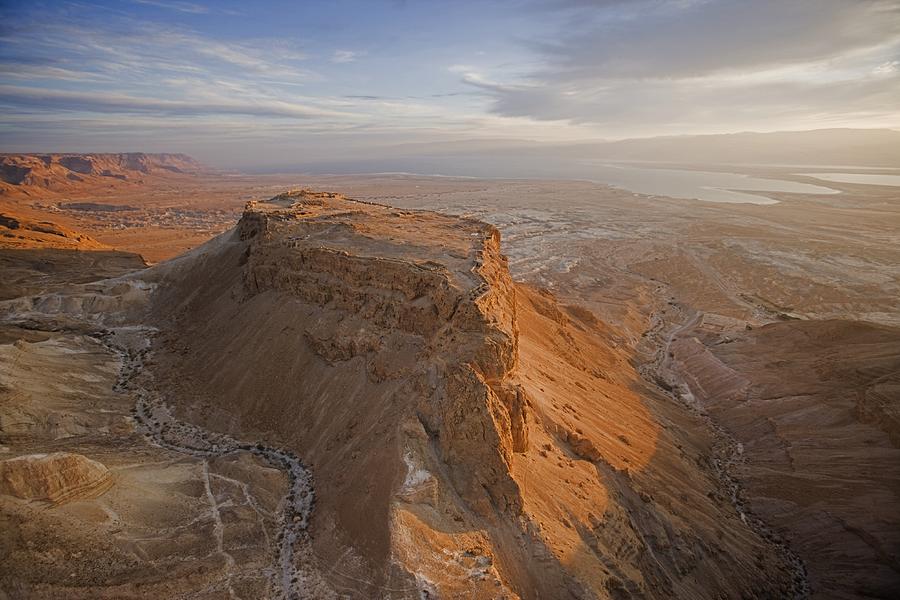
Masada

Fortress remains atop Masada

View into the wilderness south of Masada

Looking down onto the dirt-ramp built by the Romans to access the city

View to the north, from the "master bedroom" of the palace

East to the Dead Sea

Remains of the emperor's bedroom

Next we travelled to En-gedi, (which means spring of the wild goat), a lush oasis in the middle of the wilderness. This was a very familiar territory for David. He spent many years fleeing and hiding in the caves scattered throughout this hot, barren, mountainous region as he ran from the jealous King Saul. At this particular spot, David and his men were hiding deep in a cave, and the king came in to relieve himself. David’s men urged him to take advantage of this opportunity to kill Saul, but David refuses to lift a hand against the king. Instead he merely cuts off a piece of his robe. After Saul leaves the cave, David very bravely and humbly, confronts Saul and tells him what he has done, proving that he is not out to overthrow him. (1 Samuel 24). We are here in winter and even now it is very warm. The lush vegetation and the cool, refreshing springs and waterfalls, contrast the dry, dusty landscape. These caves would have been a welcome place in the heat of summer for David and his men, as well as a great hiding place.

One of the many caves in the En-gedi region

The rugged terrain where David encountered Saul

Rock Hyrax which inhabit the En-gedi

View out of En-gedi, back toward the Dead Sea

Entering the oasis

We then boarded the bus and headed for Jerusalem! We passed by Jericho and climbed up through many mountains to get to the city. We are reminded of what must have been a very long and steep journey that Jesus made on foot to come to this city each year for Passover, and then for the final Passover. We saw Bedouin shepherds, sheep, goats, and donkeys along the way. Our guide told us the Bedouins are the Israeli version of gypsies even to this day. We also saw 3 “parked “camels waiting for their masters! As we entered the outskirts of the city, we had to pass through a checkpoint. As we looked across a field of sheep and a shepherd, we were able to see the old city and the Dome of the Rock (the place where the temple used to exist) as we made our way to the Mount of Olives, overlooking the city from the east.

Entering the city of Jerusalem
When we got to the Mount of Olives, I was able to ride a camel! His name was Kojak and he was not very friendly, but it was fun!

Kojak

Getting up was half the fun

Heading for the desert
We then listened to Tim teach as we looked out over the city. We walked down the Mount of Olives, taking the road that Jesus would have used as he entered the city triumphantly on Palm Sunday, to the Garden of Gethsemane (olive press) where we sat and took communion together. This garden, with its clusters of ancient olive trees, is directly across the Kidron Valley from the eastern temple wall and is where Jesus would often retreat.

Walking down from the Mount of Olives toward Gethsemane
As the sun was going down we sat quietly and could hear birds singing, mixed with the street sounds of the bustling city – much different from the serenity of Galilee.

Garden of Gethsemane

Very old olive trees
Nevertheless, reflecting on the night of Jesus’ agony in the garden (Mark 14:32-52), knowing that this was the very spot that He prayed, knowing in both His humanity and His deity that He knew the price He would pay for me, for my sin – and still He continued on. I had no words, only thank you. Thank you for living the life I could not live and for paying the debt I could not pay. Thank you.
Lila tov
DAY 6
Today we spent the entire day in the city of Jerusalem. There was so much that we saw and so much information to digest, I am not sure that I will come close to explaining 25% of it. I will try to hit the highlights and Jeff will, as usual, fill in the rest. It is 10 PM and my feet are tired, as well as my body and brain.
We were dropped off at the south gate (known as the dung gate) of the southern wall through which we entered the old city of Jerusalem. The city is comprised of 4 quarters – the Muslim, Jewish, Christian, and Armenian quarters. Security was tight and we entered through a security checkpoint, then heard an overview of the history of the temple area, beginning with Abraham and through to present day.

Southern Gate
Then we walled a short distance to the Southern Steps that lead up to the temple. This would have been the entry point of the temple for all of the Jews in Jesus’ day. Up until today we had visited many areas where Jesus would have been near, but this is one area where we can say with certainty that we truly walked exactly where Jesus walked and taught. These are for certain the very steps that Jesus would have climbed when he came to Jerusalem, both as a child and as a man. It is still very hard to imagine that I was actually there where Jesus had been. Humbled and grateful.

The Southern Steps

Ceremonial cleansing pool at the entrance to the steps. Jesus, ironically, would have used this for ritual cleansing prior to entering the temple

View toward the Mount of Olives from the Southern Steps

The Group on the Steps
Next we went to the Western Wall of the temple mount, also known as the Wailing Wall. This is the only remaining, exposed portion of the actual retaining wall of the temple mount that the Jews can access, and is therefore a very sacred place for them; actually considered their most holy place.

Southwest corner of the Temple Mount wall; Southern Steps toward the right, Western (Wailing) Wall to the left
I really did not know much about this place and really had no expectations. [I know, unusual for me to have no expectations.] It is called the Wailing Wall because the religious Jews come here to the wall to pray and lament the destruction of the temple (by the Romans in 70 AD). The men and women have separate areas. All the men must have head-coverings. Jeff did not have one, so they provided a “cute” Yakima. There was loud wailing that could be heard coming from the men’s side. On the women’s side, as I entered I saw that the Jewish women were sitting or standing at various places. Some at the wall, some at a distance. Some were rocking back and forth. Some were reciting prayers out loud and some were silently moving their lips. Some merely bowed their heads and read. It is customary for them to write prayers, or really just anything, on small slips of paper and to place these in the cracks in the wall. Placing their prayers in the wall, they then back away from the wall and leave the area. Except for the waling coming from the men’s side, it was very quiet. I just sat at first in confusion. My heart was deeply saddened. My prayers were rising to my God, my Savior for them, that they might see the Light and come to know the Truth. The Messiah has come! Through Him our God lives in us and we are no longer in need of sacrifices or a temple.

The Wailing Wall

Praying at the Wall; notice the notes pressed into the cracks
We were then able to walk through the Western Wall tunnels, which tunnel under the existing Muslim Quarter along the base of the wall where ongoing excavation was taking place. We also saw a demonstration of the history of the temple and temple area –built by Solomon, rebuilt by Ezra and Nehemiah after the destruction of the original and after the Jewish exile, the building of the temple mount and the improvements by Herod the Great, the destruction by the Romans in 70 AD, and the building of the Dome of the Rock by the Muslims on the very spot where the temple had once stood. More on this history tomorrow.

View of the Western Wall-the covered walkway is the entrance to the top of the mount; the tunnel goes beneath the walkway and to the left along the wall under the Muslim Quarter, that is built over top and up against the wall
Afterwards we left the temple area and went out into the old city, where we had one hour for lunch and shopping. Yay! Finally some shopping, if only for a short amount of time. It was a great way to enter into the culture and meet the people. We walked to the Armenian quarter and met a nice young man named Levan, ate pizza, and continued on for the day.

Lots of school-age kids walking through the Jewish Quarter

Orange trees in a Jewish Quarter courtyard
We walked south through the Jewish Quarter and viewed the original main road through the center of the Old City. The wide central road was flanked by a covered portico/sidewalk.

The original stone and columns of the road
There is a portion of the wall that Hezekiah built in preparation for Judah's rebellion against Assyria (8th century BC). 2 Chronicles 32:3-5, 2 Kings 20:20 The remains of this wall were discovered in the Jewish Quarter of the Old City in 1970. It is about 23 feet thick and still stands up to 10 feet tall.

Hezekiah's Wall
We saw the actual wall and then walked to the City of David – the original city that King David conquered and established as his capital. This city is actually outside the existing walls of Jerusalem.

Sculpture on entrance to the City of David
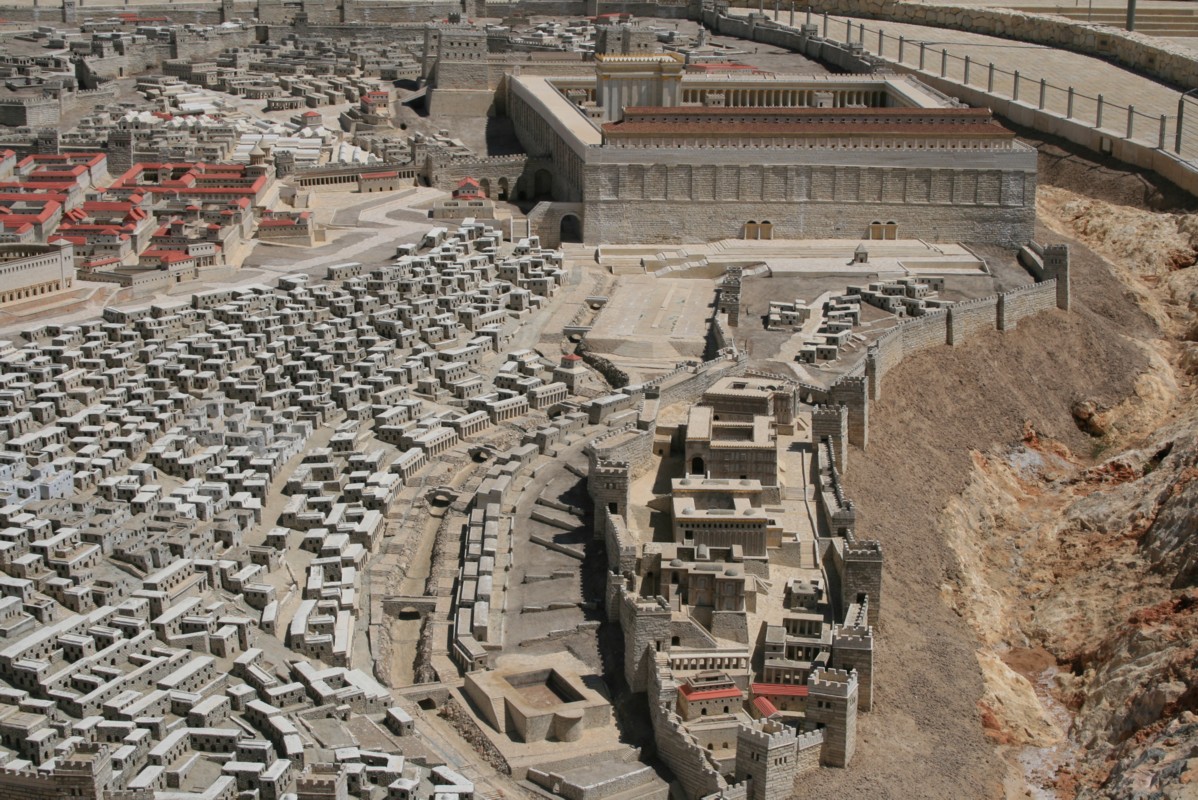
Model of the ancient City of David in foreground and how it related to the eventual expansion of the city of Jerusalem. At the top is the Temple Mount (built on what was Mount Moriah in David's day), to the right of the city is the Kidron Valley, along the left side the Central Valley (also know as Valley of the Cheesemakers)

Excavation of City of David

View of the Modern City of Jerusalem from City of David

Cemetery to the east of the walled city, toward the Mount of Olives
Part of Jerusalem’s ancient water system was located under the City of David. It connects the Gihon Spring—Jerusalem’s fresh water supply—with the Siloam Pool. According to 2 Chronicles 32:2–4 and 2 Kings 20:20, this tunnel was dug during the reign of King Hezekiah of Judah to prepare Jerusalem for the imminent attack of the Assyrian king, Sennacherib. Hezekiah redirected the water through old and newly dug Jerusalem tunnels to prevent the Assyrians from cutting off the water supply
We had the choice of walking through the tunnel still containing water up to our knees, or walking through a dry tunnel – we went with the dry tunnel known as the Canaanite Tunnel.
At the end of Hezekiah’s tunnel is the Pool of Siloam.

Steps leading down into the Pool of Siloam
This is another spot where we can say, with certainty that Jesus actually was! The very place that He healed the man that was blind since birth, causing a “balagan” with the religious leaders ( John 9:1-7).
(Balagan is a Hebrew word that our guide, David, has been using everyday - describing a big mess or trouble.)
We then decided to call it a day.

The Old City at dusk looking toward the Southern steps
We returned to the hotel and had dinner, but then walked back to the old city, entering through the Jaffa Gate, to wander around the city a little more. Finally, to bed.
Lila tov
DAY 7
We returned today to the Old City of Jerusalem and entered again through the Dung Gate. This time we were to visit the Temple Mount, which is one of the most important religious sites in Jerusalem, both for the Jews as well as the Muslims. The present site is dominated by two important structures: the al-Aqsa Mosque and the Dome of the Rock.
There is so much history on this Mount. This is the location of Mount Moriah where Abraham sacrificed Isaac. This is the place where Solomon built the grand temple for Yahweh. That temple was destroyed, then later rebuilt by Ezra and Nehemiah after the Jewish exile period. This temple was more modest than the original, but when Herod the Great came into power he established the Temple Mount (an elevated plateau surrounded by four walls) on which a more glorious and ornate temple was built. This is the temple where Jesus taught and overthrew the money changers in the court. It was destroyed by the Roman Empire in 70 AD. Afterwards the site remained undeveloped for six centuries, until the Arab conquest. A beautiful shrine called the Dome of the Rock was built in 691 that sits over the ROCK, a remnant of Mount Moriah where it is thought that the Jewish Temple was situated. Some believe this to be the exact place where the Holy of Holies was located. The location is the holiest site in Judaism and is the place Jews turn towards during prayer. Due to its extreme sanctity, many Jews will not walk on the Mount itself, to avoid unintentionally entering the area where the Holy of Holies stood.
Among Sunni Muslims, the Mount is widely considered the third holiest site in Islam, revered as the Noble Sanctuary and the location of Muhammad's journey to Jerusalem and ascent to heaven. After the Muslim conquest of Jerusalem in 637 AD, Umayyad Caliphs commissioned the construction of the al-Aqsa Mosque and Dome of the Rock on the site. In light of the dual claims of both Judaism and Islam, it is one of the most contested religious sites in the world. Since the Crusades, the Muslim community of Jerusalem has managed the site as a Waqf, without interruption. As the site is part of the Old City, controlled by Israel since 1967, both Israel and the Palestinian Authority claim sovereignty over it, and it remains a major focal point of the Arab–Israeli conflict. In an attempt to keep the status quo, the Israeli government enforces a controversial ban on prayer by non-Muslims.
This is probably the hottest and most disputed piece of real estate in all the world. Surprisingly, the security as we entered was not as tight as entering the Jewish Western Wall, although Israeli soldiers armed with automatic weapons patrolled the area. This was a very different experience from the Wailing Wall. It was a quiet setting for the most part. It is very unusual for a religious Jew to enter and walk on the Mount because he would NEVER want to step on the Holy of Holies place since no one knows exactly where it was. While we were there, however, a religious Jew came walking by [with no shoes on] and this created a huge ruckus (big balagan) among the Muslims in the area, who jeered and made rude, loud comments in Arabic! This also happened a second time: I had just passed some older, grandmotherly Muslim women who smiled pleasantly and said “salam”. Then just a few moments later, these same women started chanting loudly at a religious Jew. These chants were not very pleasant. Then I watched as they went on to what was most likely a study of the Koran, hugging, and laughing with their friends. Other groups were gathered elsewhere quietly. My heart was somewhat numb with very little feeling. This people also desperately need King Jesus to set them free.

Israeli soldiers on the Temple Mount

Front door of the al-Aqsa Mosque

Front access to the Dome of the Rock

Dome of the Rock

Arches on the Mount

Rear stairway to the Dome

Courtyard behind the Dome leading to the Muslim Quarter

Groups of women studying the Koran
We left the Temple Mount and exited through the Lion's Gate. The Lions' gate is located on the north-east walls of the old city of Jerusalem, leading to the Via Dolorosa. It is sometimes called Stephen's Gate, because this is the gate that he was led out of and stoned.


Lion's Gate
We continued on to the place known as the Upper Room on Mount Zion – the place that Jesus met with His disciples on the night of His betrayal, the night before His crucifixion.The room is on the upper floor of a two-story building near the Basillica of the Assumption, south of the Zion Gate in the walls of Jerusalem’s Old City. This was also the place that His disciples and followers had gathered to wait for the coming of the Spirit after He had ascended.

Basillica of the Assumption on Mount Zion
Entering the Christian quarter, there was a completely different sense. Freedom! Jesus the Messiah has come! Praise God for the gift of the His Son!
We then went to the Israel Museum where there is a detailed, very large scale model of the city of Jerusalem from Jesus’ day. It was very beautiful, helpful, and interesting to have this visual overview of the layout of the city. Many details of the city came alive in our minds with this spectacular display! Also there was more information of the Dead Sea Scrolls some of the actual non-canonical scrolls on display.



The Antonia Fortress was a military barracks built around 35 BC by Herod the Great . The fortress was built on the northeastern side of the city, near the Temple Mount and the Pool of Bethesda.

How the Jewish Temple would have looked on the Mount
Then on to the Holocaust Museum (Yad Vashem) – As the Jewish people’s living memorial to the Holocaust, Yad Vashem safeguards the memory of the past and imparts its meaning for future generations. It was stablished in 1953 as the world center for documentation, research, education and commemoration of the Holocaust. While the Nazi persecution of the Jews began in 1933, the mass murder was committed during World War II. Over a 4 year period at least 6 million Jews, including 1.5 million children, were murdered. There was a separate museum to commemorate the lost children. A darkened room illuminated by a single candle in the center of the room, but magnified by a multitude of prisms and mirrors that scattered thousands of points of light around the room, was the setting. A continuous recording, which read the names of the children in English, Hebrew, and Aramaic, was played - it was said that it takes 3 1/2 years for all of the names to be read. The museum was both horrifying and sobering. The atrocities committed against the Jews were hard to imagine. In a world of total moral collapse there was a small minority who mustered extraordinary courage to uphold human values. These were called the Righteous Among the Nations - individuals who acted in the face of the atrocities to assist by hiding Jews, providing false identities or false papers, smuggling or assisting Jews to escape, and saving children. They stood in stark contrast to the mainstream of indifference and hostility that prevailed during the Holocaust. Contrary to the general trend, these rescuers regarded the Jews as fellow human beings who came within the bounds of their universe of obligation. They are given special recognition within the museum and, interestingly, they have been offered Jewish citizenship as a result of their actions. We took no pictures within this memorial.
Our last stop of the day was Bethlehem – the city of Jesus’ birth. This city is now primarily an Arab city, under Palestinian control. So we had to go through a security checkpoint and even got a new guide, Ramzi. Since our original guide, David, is Jewish and serves in the Israeli reserves, he could not accompany us into the city. The population of the modern city is about 35,000 and is 80% Muslim and 20% Arab Christian.

Wonder if Starbucks is aware of this copyright infringement?
We drove down Nativity Street which it is believed to be the road that Mary and Joseph would have taken as they entered the city.

Dwellings along Nativity Street

Downtown plaza near the church
We stopped at the Church of the Nativity where a cave that is believed to be where Jesus was born is located. The church is owned by three denominations – Greek Orthodox, Armenian, and Catholic. This is the oldest church that is still in use in the world! The church is built over the cave, or grotto, where His birth took place.

Church of the Nativity

Original mosaic floor of the church
The last stop of the day was to view Shepherd’s Field – a grassy, rocky slope that may have been the place where the shepherds would have been tending their sheep on that glorious night when the angels’ pronouncement was made! “Glory to God in the Highest and on earth, peace, good will to men!” Baby Jesus, born of a virgin, who came to die for the sins of men.

View of the hillside - sorry for the blur
We then stopped at an Arab Christian shop that produced and sold various articles made of wood from the many olive trees in that region. Finally we proceeded back through the checkpoint, which took 45 minutes, and headed back to Jerusalem.
After returning to the hotel, I had the privilege to go with Sheri to the house of her friend that lives here in Jerusalem. Kay is British and is married to an Arab Christian who teaches Theology at Bethlehem Bible College. She sells handmade items from the “marginalized” people from Bethlehem. Life is very, very hard for the Arab Christians in Bethlehem – they are often shunned by the predominantly Arab Muslims in the city and must live in isolation because of the tight control of the city’s access by the Israelis. She buys their handmade items to provide an income for them and then sells the items outside of Bethlehem for a profit; she then gives the profits to aid the Palestinian refugees. The items were beautiful, but not nearly as beautiful as her honest, humble heart and being in her gracious home.
Once again, a late bedtime with an early rising in the AM.
Lila tov
DAY 8
This is the last day. We have been getting very little sleep and rising every day at 6 AM for the past eight days– with no days of rest. Today will be our last day in the Holy City of Jerusalem. We started the day by entering the old city through the Lion’s Gate and headed to the Pool of Bethesda. We can know for certain, from the story in John 5:1-16, that Jesus stood in this exact location. The Pool of Bethesda was known for healing powers when its waters were stirred by an angel. Because of this, many sick people – blind, lame, paralyzed, came to the pool, waiting for the stirring of the water. One day when Jesus came by, He saw a man that had been lame for 38 years waiting to be placed into the waters. Jesus asked him: “Do you want to be healed?” What a strange question for someone who has been unable to walk for 38 years. Jesus knows the hearts of all men and yet, knowing this man’s heart, specifically asked him this question. The man answers that he has no one to place him into the pool. Jesus then speaks and the lame man is immediately healed which causes a problem for the Jews because he was healed on the Sabbath. There were five porches located here and the pool was fed by a spring. The beautiful St. Anne’s Church, a Crusader church, is also located here. This is the only church in the city that was not destroyed by the Arabs. The church was dedicated to Anna and Joachim, who according to tradition, lived here. The church was built over the site to commemorate where their daughter, Mary was born. The acoustics in the church are fantastic, so various groups go in and sing! We had the opportunity to sing praises to our God twice!

The Pool of Bethesda
We then began our walk along the Via Dolorosa (Way of Grief). This is the path of agony that the Jesus took carrying the cross to Golgotha. This began at the Antonia Fortress where He was tried, beaten, and sentenced to death. The Fortress was built in 35 BC to protect the Temple Mount and functioned as headquarters for the Roman soldiers. (This is also the place where Paul was taken by the Roman soldiers after he incited a riot by preaching the Gospel on the Temple Mount in Acts 21:30 -22:29). This is traditionally where the trial took place, but there are some that think that the trial may have taken place at Pontius Pilate’s palace, which would change the route of the Via Dolorosa.
The Via Dolorosa is marked with 14 stations. Near the Fortress was the actual stone pavement and at one location was an etching in the stone that the Roman soldiers used to play the “Game of the Kings”- they would have the condemned person throw a dice or marker on the “game board” and where the dice landed would determine how he would be tortured. One of the options would be a quick death, but the other options were horrible. It is likely that Jesus was subjected to this game.
Today the path is narrow and filled with various Muslim vendors. Back in Jesus’ day the path would have been narrow and filled with many people shouting and jeering at the condemned.


Streets along the Via Dolorosa
The path ends outside the city walls at the Church of the Holy Sepulcher built on Golgotha, the rocky hill shaped like a skull on which Jesus was crucified. This church was built by Constantine in 333 to commemorate the death and burial of Jesus. His mother, Helena, chose this site based on the local history of it being a place of execution in the time of Jesus . Other factors that favor this location include the existence of a nearby garden and tombs , as well as her finding fragments of wood planks that were likely used as cross pieces. The church is old, very large, and dark inside. There is a place inside where you can actually touch a piece of the Golgotha rock. The church is owned by 6 denominations – Armenian Orthodox, Greek Orthodox, Syrian Orthodox, Ethiopian Orthodox, Coptic Christian, and Roman Catholic. Also inside the church is located an actual empty tomb hewn into the rock. It was an example of the type of tomb that Jesus would have been laid in.
For on that early morn, the women came to the tomb to anoint His body, found the stone had been rolled away, and an angel greeted them with these words: “Why do you look for the living among the dead? He is not here, for He has risen!” (Luke 24:1-7)

Church of the Holy Sepulcher

It was a little difficult at times to block out all the distractions and remind myself of what actually happened in this place over 2000 years ago. Even if this was not the exact spot, this was certainly close to the place where He died and three days later rose from the dead. One thing is for CERTAIN: As Paul wrote in 1 Corinthians 15:1 “Moreover brethren, I declare to you the gospel which I preached to you… That Jesus Christ died for our sins according to the Scriptures, and that He was buried, and that He was rose again the third day according to the Scriptures…” Hallelujah, what a Savior!
We then spent time shopping in the streets of the old city in both the Muslim and Jewish quarter. One thing I loved in Galilee and Jerusalem was having fresh squeezed pomegranate juice sold by the vendors. Pomegranates are plentiful in Israel and some actually believe that the fruit that Adam and Eve picked was a pomegranate.
Our last stop was the Garden Tomb which was located outside the Damascus Gate. This is another spot that has been suggested to be a possible location of Golgotha and the empty tomb. This is a very quiet, beautiful garden setting. The rocky hill resembles a skull and a tomb was discovered in 1882 by British General Gordon. Here we saw a tomb like one that Jesus would have been placed in and a stone like the one that would have been placed in front of the entrance. Interestingly, there were grooves in front of the grave where the stone would roll. We worshiped together as a group in this quiet setting and reflected on all that we had seen and heard over the past days.

The rocky hill at the Garden tomb

Entrance to the grave at the Garden Tomb

A rock that would have been used to seal off the tomb

An ancient winepress in the Garden
We ended the day having dinner at a very cool old hotel called the American Colony, then boarded the bus for the trip to the Tel Aviv airport to catch an overnight flight back to the USA –it will take us a total of 18 hours to get back to Greenville. For the last time…..
Lila tov
From Deb: This has been a remarkable, marvelous journey. One that I am not sure I can put into words and summarize well. There was so much to see and absorb and I know that I only absorbed a small amount of it all. Starting at Galilee, then travelling through the wilderness, and then ending in Jerusalem, my mind was constantly operating on overload. It will take some time to process it all. My thoughts and prayers go to my Savior and God for all that He has done and is doing in my life. All praise to Jesus for His gift of love and mercy and the grace that He pours out on me every day! “But God, who is rich in mercy, because of his great love with which He loved us, even when we were dead in sin, made us ALIVE together in Christ (by grace you have been saved)…(Ephesians 2:4)
From Jeff: I agree with Deb - I am still trying to process all of the sights, sounds, information, and experiences of the last 8 days. This experience has been like none other. Being able to put the scriptures that I have studied and love in the context of the land and locations in which they were written, and where the stories took place, has been incredible. It has helped me to make connections and have understanding that I did not have prior to the trip. Seeing the various sites and excavations, and seeing how the history and the archaeological findings line up with the Biblical accounts has served to confirm my trust in the scriptures and increase my awe of a mighty God. I trust God will continue to use this experience to draw me closer to Himself, and I praise Him for this opportunity.
